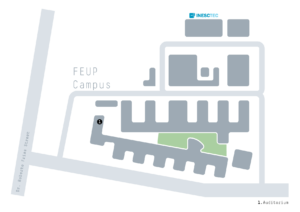University of Porto | Faculty of Engineering

The Faculty of Engineering of the University of Porto (FEUP) was created in 1926. Still, its history began a century before within the Polytechnic Academy of Porto to “plant industry science in the country”.
The Faculty of Engineering of the University of Porto undertakes education, research, and innovation activities at the international level. The results of these activities lead to the creation and transfer of knowledge, training of competent and ethical professionals, future leaders in engineering and similar areas, and the promotion of our global society’s well-being.
With a workforce of over 1.000 collaborators, including more than 600 teachers, FEUP offers over 90 degree and non-degree courses, which enrolled around 9.000 students in the last academic year.
Source: FEUP

Photo credits: Engenharia Radio
The UT Austin Portugal 2021 Annual Conference will be held in a hybrid format. The event’s venue will be the FEUP’s Main Auditorium, located in the Asprela Campus. Sessions taking place in a hybrid setting may have speakers/moderators participating either remotely or onsite and interacting with participants at the venue or connecting remotely. Being an international event, remote attendees may join from different locations in the world.
Faculdade de Engenharia da Universidade do Porto
Rua Dr. Roberto Frias
4200-465 Porto
Portugal
41.17855261102346, -8.595838656216014
view map
Porto, a city to discover
Located along the Douro River estuary in the North of Portugal, Porto is the second-largest city in Portugal and one of the Iberian Peninsula’s major urban areas. Meeting the coastline of the Atlantic Ocean, Porto is one of the oldest European urban centres. Indeed, the entire Historic Centre of Oporto is classified as a National Monument.
Porto is a city to visit manly on foot, seizing the ancient streets and the characteristic monuments, flavoring the typical delicacies or meeting the iconic people. There are a lot of places to visit and many different activities to do, including strolls by the riverside, dives in blue flagged beaches or rides in the historical tram tours.
Stories say that this historic city had also a great influence on the name of the country. With a center river mouth location known as “Cale”, later called by the Romans “Portus Cale” derived of the port setting, the designation later resulted in “Portucale”, and finally the name “Portugal” arose.
You can find relevant information about the city of Porto on the following websites:
